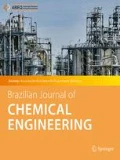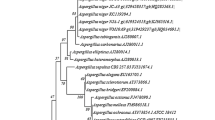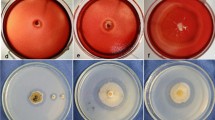Abstract
Liquor from pretreatment of sugarcane bagasse is a potential substrate for multiple purposes due to the high concentration of residual sugars. Nevertheless, several potentially toxic byproducts are also present. However, a few microorganisms are able to overcome this toxicity by growing on these liquors. Twenty-five filamentous fungi were evaluated in submerged cultivation, but none was able to grow using liquor at a concentration of 100% as the liquid medium. However, six fungi were selected for enzyme induction after being grown in diluted liquor at 50% (v/v) using two feed pulses. Induction experiments were performed using 1% untreated and pretreated sugarcane bagasse. FPase and xylanase activities were detected for all six fungi in submerged cultivation, whereas β-glucosidase was observed in four fungi. The highest xylanase activity (28.8 IU mL−1) was at 72 h for T. harzianum P49P11 using pretreated-SCB as an inducer. This work showed a successful alternative for the final destination of liquor residue as substrate for fungi cultivation prior to enzyme production.






Similar content being viewed by others
References
Aguiar MM, Pietrobon VC, Pupo MMS, Torres NH, Américo JHP, Salazar-Banda GR, Silva DP, Monteiro RTR, Ferreira LFR (2018) Evaluation of commercial cellulolytic enzymes for sugarcane bagasse hydrolysis. Cell Chem Technol 52:695–699
Alvira P, Tomás-Pejó E, Ballesteros M, Negro MJ (2010) Pretreatment technologies for an efficient bioethanol production process based on enzymatic hydrolysis: a review. Bioresour Technol 101:4851–4861
Barros RDROD, Paredes RDS, Endo T, Bon EPDS, Lee S-H (2013) Association of wet disk milling and ozonolysis as pretreatment for enzymatic saccharification of sugarcane bagasse and straw. Bioresour Technol 136:288–294
Callow NV, Ju L (2012) Promoting pellet growth of Trichoderma reesei Rut C30 by surfactants for easy separation and enhanced cellulase production. Enzyme Microb Technol 50:311–317
Cherubini F, Jungmeier G, Wellisch M, Willke T, Skiadas I, Van Ree R, Jong E (2009) Toward a common classification approach for biorefinery systems. Model Anal Biorefinery Classif 3:534–546
Cunha FM, Esperança MN, Zangirolami TC, Badino AC, Farinas CS (2012) Sequential solid-state and submerged cultivation of Aspergillus niger on sugarcane bagasse for the production of cellulase. Bioresour Technol 112:270–274
da Delabona SP, Farinas CS, da Silva MR, Azzoni SF, da Pradella JGC (2012) Use of a new Trichoderma harzianum strain isolated from the Amazon rainforest with pretreated sugar cane bagasse for on-site cellulase production. Bioresour Technol 107:517–521
da Delabona SP, Sanchez C, Juliana D, Geraldo J (2013) Experimental mixture design as a tool to enhance glycosyl hydrolases production by a new Trichoderma harzianum P49P11 strain cultivated under controlled bioreactor submerged fermentation. Bioresour Technol 132:401–405
da Delabona SP, Lima DJ, Robl D, Rabelo SC, Farinas CS, da Pradella JGC (2016) Enhanced cellulase production by Trichoderma harzianum by cultivation on glycerol followed by induction on cellulosic substrates. J Ind Microbiol Biotechnol 43:617–626
De Jong E, Jungmeier G (2015) Biorefinery concepts in comparison to petrochemical refineries. Elsevier, Amsterdam, pp 3–33
El-Enshasy HA (2007) Filamentous fungal cultures—process characteristics, products, and applications. In: Yang S-T (ed) Bioprocessing for value-added products from renewable resources. Elsevier Press, Amsterdam, pp 225–261
Fillat U, Ibarra D, Moreno AD, Tomas-pejo E (2017) Laccases as a potential tool for the efficient conversion of Lignocellulosic biomass: a review. Fermentation 3:1–30
Gitifar V, EslamLoueyan R, Sarshar M (2013) Bioresource technology experimental study and neural network modeling of sugarcane bagasse pretreatment with H2SO4 and O3 for cellulosic material conversion to sugar. Bioresour Technol 148:47–52
Jönsson LJ, Alriksson B, Nilvebrant N-O (2013) Bioconversion of lignocellulose: inhibitors and detoxification. Biotechnol Biofuels 6:16
Kim Y, Mosier NS, Ladisch MR (2009) Enzymatic digestion of liquid hot water pretreated hybrid poplar. Biotechnol Prog 25:340–348
Kim Y, Ximenes E, Mosier NS, Ladisch MR (2011) Soluble inhibitors/deactivators of cellulase enzymes from lignocellulosic biomass. Enzyme Microb Technol 48:408–415
Kim Y, Kreke T, Hendrickson R, Parenti J, Ladisch MR (2013) Fractionation of cellulase and fermentation inhibitors from steam pretreated mixed hardwood. Bioresour Technol 135:30–38
Klinke HB, Thomsen AB, Ahring BK (2004) Inhibition of ethanol-producing yeast and bacteria by degradation products produced during pre-treatment of biomass. Appl Microbiol Biotechnol 66:10–26
Ko JK, Ximenes E, Kim Y, Ladisch MR (2015) Adsorption of enzyme onto lignins of liquid hot water pretreated hardwoods. Biotechnol Bioeng 112:447–456
Kumar AK, Sharma S (2017) Recent updates on different methods of pretreatment of lignocellulosic feedstocks : a review. Bioresour Bioprocess 4(7):1–19
Lee SH, Lim V, Lee CK (2018) Newly isolate highly potential xylanase producer strain from various environmental sources. Biocatal Agric Biotechnol 16:669–676
Michelin M, Polizeli MDLTM (2012) Xylanase and β-xylosidase production by Aspergillus ochraceus: new perspectives for the application of wheat straw autohydrolysis liquor. Appl Biochem Biotechnol 166:336–347
Michelin M, Ximenes E, Polizeli MLTM, Ladisch MR (2016) Effect of phenolic compounds from pretreated sugarcane bagasse on cellulolytic and hemicellulolytic activities. Bioresour Technol 199:275–278
Miller GL (1959) Use of dinitrosalicylic acid reagent for determination of reducing sugar. Anal Chem 31:426–428
Panneerselvam A, Sharma-Shivappa RR, Kolar P, Ranney T, Peretti S (2013) Potential of ozonolysis as a pretreatment for energy grasses. Bioresour Technol 148:242–248
Parawira W, Tekere M (2011) Biotechnological strategies to overcome inhibitors in lignocellulose hydrolysates for ethanol production: review. Crit Rev Biotechnol 31(1):20–31
Payne CM, Knott BC, Mayes HB, Hansson H, Himmel ME, Sandgren M, Ståhlberg J, Beckham GT (2015) Fungal cellulases. Chem Rev 115:1308–1448
Perrone OM, Colombari FM, Rossi JS, Moretti MMS, Bordignon SE, da Nunes CC, Gomes E, Boscolo M, Da Silva R (2016) Ozonolysis combined with ultrasound as a pretreatment of sugarcane bagasse: effect on the enzymatic saccharification and the physical and chemical characteristics of the substrate. Bioresour Technol 218:69–76
Robl D, da Silva PD, dos Costa PS, da Lima DJS, Rabelo SC, Pimentel IC, Büchli F, Squina FM, Padilla G, da Pradella JGC (2015) Xylanase production by endophytic Aspergillus niger using pentose-rich hydrothermal liquor from sugarcane bagasse. Biocatal Biotransform 33:175–187
Travaini R, Otero MDM, Coca M, Da-Silva R, Bolado S (2013) Sugarcane bagasse ozonolysis pretreatment: effect on enzymatic digestibility and inhibitory compound formation. Bioresour Technol 133C:332–339
Acknowledgements
The authors would like to thank the technical staff of the National Laboratory of Science and Technology of Bioethanol (CTBE) and acknowledge the financial support provided by the Brazilian agency CAPES (finance code 001).
Author information
Authors and Affiliations
Corresponding author
Additional information
Publisher's Note
Springer Nature remains neutral with regard to jurisdictional claims in published maps and institutional affiliations.
Rights and permissions
About this article
Cite this article
Bordignon, S.E., da Silva Delabona, P., Lima, D. et al. Induction of fungal cellulolytic enzymes using sugarcane bagasse and xylose-rich liquor as substrates. Braz. J. Chem. Eng. 37, 443–450 (2020). https://doi.org/10.1007/s43153-020-00055-5
Received:
Revised:
Accepted:
Published:
Issue Date:
DOI: https://doi.org/10.1007/s43153-020-00055-5




